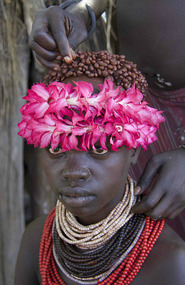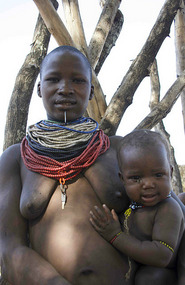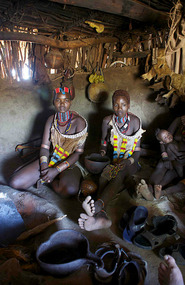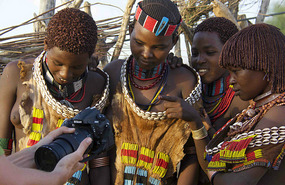We retraced our steps back to Jinka where we had some lunch. That 70 km journey is the one many Mursi people make every week to the Jinka market and it takes them at least 2 days. Unfortunately we did not have time for the Jinka market, but we went straight to the Keyafar market in a neighbouring village some 30 mins west of Jinka. This market was in Banna territory, but was also visited by the Hamar tribe. This market was primarily a food market and visited by many people plus several tourists as it was on the main tarmac road from Abra Minch to Jinka.
When we arrived it was already hot and there were plenty of tribal people milling around in their traditional outfits
. In the old days, the tribespeople only dressed in their traditional clothes on these market days, but nowadays they dress traditionally during the tourist season.
Here in the market, photography appeared to be tolerated as long as it was just general shots, otherwise the subject would demand a 5B fee. These general shots were easy as most of the tribal visitors settled down under the trees to talk and drink honey beer. It was a time to catch up on the gossip and see old friends. Other groups of older women sat together in the sun selling an interesting range of spices and beans with red ‘lips’, together with some unusual greens. There was also a little fruit available and plenty of honey, tobacco, clay, corn and sorghum.
The Banna tribe dressed in a similar way to the Hamar and both tribes had adopted some 21st century items into their fashion ensemble. These included coloured hair grips, umbrellas, water and soft drink labels plus plastic beads. What was really impressive though was the Hamar women’s use of a dark red clay in their platted hair. This was newly applied for market day and glistened in the afternoon sun. This was not unique to the Hamar, but they were unusual in fastidious way they applied the clay. On many women it had a sort of moist look.
Also there were several young Hamar men also wandering around in their market day clothes clutching their little wooden stools in their hands
. Mamo said these Hamar men were handing out invitations to a bull jumping. This involved giving other Hamar people pieces of rope tied with knots. The knots indicate the date, the place and the time of the bull jumping. Unfortunately we did not see these invitations, but we were shown the grasses from which the rope was made.
We eventually called time on the market and headed off for a drink at a local restaurant called the Aman Hotel. This was allegedly owned by a friend of Mamos, but the establishment ended up trying to charge us close to $25 for four soft drinks and two coffees. “Farangi price” again. The inevitable argument resulted and the bill was reduced somewhat, but this was still some five times higher than the locals pay. Of course this highly objectionable practice was facilitated by the local restaurant owners refusal to produce or write a menu, which is illegal in Ethiopia.
After a two hour drive south towards the Kenyan border we arrived at Turmi, in the heart of the land of the Hamar people. It was little more than a dusty collection of shacks on a major T junction. Here we went straight to the campsite, a lovely secluded place underneath some mango trees next to a drive river bed. The campsite was owned by a local Hamar chef and was managed by a Hamar lady complete with clay hair, tribal outfit and a huge smile
. After the overcharging of Keyafar this was a welcoming, friendly place which was clean and comfortable. The wildlife and birds here were great (when the drivers were not playing their stereos at full blast). We had a local meal and turned in.
The tents were remarkably comfortable and we had a good night sleep, and we were roused at 5.00am for another three hour trip on bumpy dusty roads to vista the Kao tribe in the west of the Mago National Park. The Karo are a tribe famous for their fishing (on the banks of the Omo River) and their face painting and we were determined to arrive before the other tourists, so we could meet them on our own and when the light was at its best.
The Karo people did not disappoint and we arrived early, as the village was rousing. Unfortunately the tribe was having none of the group photography deal and continually thwarted Mamo’s attempt to secure a more cost effective deal for Stefan and myself, so in the end we just negotiated away with the individuals. They were though very photogenic and decorated themselves on their faces and the bodies in front of us to show us the process. They used clay from the Omo river and the girls also used a specific flower from the desert. Some of the young warriors looked magnificent. I found one and managed to have a conversation with him, after surprisingly finding out he spoke some English
. “How old are you?” I ended up asking. “17” he replied (which was much younger than I thought). “How old are you? he retorted. “Nearly 50,” I said, to which he looked at me and uttered “wow, thats older than my grandfather!” This did not make me feel good.
In the end we sat with the elders under a tree overlooking the Omo Valley and Stefan asked his questions again (much to the growing irritation of Mamo). It was a great visit and we left as more 4x4s arrived.
After lunch we returned to the campsite for a rest at which point the driver started munching on some chat. Chat is a plant that when chewed gives a high and leaves the individual in a semi zombie state. Soon the driver was zombified, but as Mamo had only planned a local excursion to a nearby Hamar village, he decided he would drive himself.
We arrived at this village just before the sun started going down and were invited into a Hamar house for coffee. Like with the Mursi tribe this was coffee made from the bean husks, but refreshing nevertheless - sort of like Nescafe. Two young Harmer girls invited us into their hut, showed off their traditional attire and let us look around their two story hut. It was made from a local wood which is termite resistant with a large communal seating area (the floor) on one side covered with animal skins and a sleeping area opposite and a fire. Upstairs was the storage and an additional sleeping area, if rehired. Children ran around the hut and it easily accommodated the seven of us plus a baby goat. The entrance was though tiny (to prevent other domestic animals from gaining entrance) and we all had to perform a serious contortion to get inside.
The hospitality was very warm and friendly and this was a great visit. When we did finally emerge from the hut, the rest of the village had gathered and we proceeded to snap pictures this time at our leisure. The children were especially alluring here and we also met several women with aliments and wounds who had come hoping for treatment. Stefan who seemed very adept with first aid duly obliged. We then left for dinner in Turmi, after rounding up the comatose driver returned to the campsite where I left the other three drinking beer and retired early.
The following morning was a far more relaxed morning than the previous ones and we had a lie in before hitting Turmi for breakfast. We then drove back up the main gravel road for some thirty minutes to the Dimak market. This market Mano assured us was one of the most interesting in the area involving many Hamar tribespeople and their cattle, but this was also where we hoped to have the bull jumping location confirmed. Although nothing is ever guaranteed in this neck of the woods, Mano seemed confident that we would be attending bull jumping that afternoon.
The market was hot, crowded and very interesting with groups of Hamar tribespeople gathering from miles around. We walked into the main part of town with the Hamar who were arriving on foot (some after very long journeys) with their wares to sell. It was all very colourful and again once in town the women sat in groups selling their produce according to type. Flowers, grasses, tobacco, honey, clay etc etc
The outfits were outstanding and whilst we tried to take photos at a distance, if we decided on taking a portrait again we had to pay. Mano again did the negotiation. Stefan found a Hamar lady to ask his questions too, and when he asked his final question “is there anything you would like to ask me?” She replied, “yes can you buy me some food, as my husband died last year and I am finding it very difficult to feed my kids!” This was a heartbreaking story and both Stefan and myself readily agreed. Mano also chipped in we bought her a large sack of corn. She then introduced us to the wife number one, as she turned out to be wife number two and they were both so grateful - it was very touching. Within twenty minutes though we had experienced the complete opposite when a Hamar woman accused us of taking photos of her, when we were not and demanded money. She got quite hysterical in front of a large audience of some thirty tribes people.
The market was great, and the cattle market section was particularly fascinating with the men bargaining in dramatic and theatrical fashion. It was here that my new memory card jammed losing all the cattle market shots (it was a new one so I lost just 40 snaps, but all the cattle market) and this was very annoying. As the sun rose in the sky to full strength, we retired to a local cafe for some tea. It was here that Mamo found out that the bull jumping was in fact on the following Monday and not on this Saturday which rather torpedoed our plans for the rest of the day.
We remained at the market until the late afternoon and then returned to Turmi for the enviable beer and chat around the camp fire. With the amount of beer being drunk I told Mamo that whilst I was happy to buy one or two for him and the driver, as they were now starting to drink 10 to 15 each per night I was not paying for this any more. Beer is not cheap in Ethiopia, and this practice is just taking the Mickey! This seemed to be accepted by Mamo and the driver, but I had a sneaking suspicion that it would cause an issue later in the trip.
Hamar, markets, clothes and free beer (not for me)
Saturday, March 08, 2014
 Turmi, And People's Region, Ethiopia
Turmi, And People's Region, Ethiopia
Other Entries
-
27Rhinos, Armed Guards & Posing For Photos
Nov 14114 days prior Kaziranga National Park, Indiaphoto_camera5videocam 0comment 0
Kaziranga National Park, Indiaphoto_camera5videocam 0comment 0 -
28Spiders, The Kharsi, Archery and Bad Driving
Nov 20108 days prior Cherrapunji, Indiaphoto_camera5videocam 0comment 0
Cherrapunji, Indiaphoto_camera5videocam 0comment 0 -
29Monpas, Sumo, Yak Butter Tea & Indian Army
Nov 24104 days prior Tawang, Indiaphoto_camera7videocam 0comment 0
Tawang, Indiaphoto_camera7videocam 0comment 0 -
30Uncles, Nuns, Bridges, Red Rice and Gompas
Nov 27101 days prior Sakti, Indiaphoto_camera5videocam 0comment 0
Sakti, Indiaphoto_camera5videocam 0comment 0 -
31Buddhist Festival, Feral Dogs, Exploding Cakes
Dec 0197 days prior Bomdila, Indiaphoto_camera6videocam 0comment 0
Bomdila, Indiaphoto_camera6videocam 0comment 0 -
32A Horror Journey
Dec 0395 days prior Tezpur, Indiaphoto_camera4videocam 0comment 0
Tezpur, Indiaphoto_camera4videocam 0comment 0 -
33Hornbill Festival, Nagas & Nagaland
Dec 1088 days prior Kohima, Indiaphoto_camera6videocam 0comment 3
Kohima, Indiaphoto_camera6videocam 0comment 3 -
34Pied Pipers, Hard Beds, Ao and Chang tribes
Dec 1880 days prior Mokokchung, Indiaphoto_camera7videocam 0comment 0
Mokokchung, Indiaphoto_camera7videocam 0comment 0 -
35Battles, Monoliths, Street Photography, Home
Jan 0166 days prior Dubai, United Arab Emiratesphoto_camera6videocam 0comment 0
Dubai, United Arab Emiratesphoto_camera6videocam 0comment 0 -
36Athens, Bristol, Doctors and Rain - lots of rain
Jan 1552 days prior Athens, Greecephoto_camera2videocam 0comment 0
Athens, Greecephoto_camera2videocam 0comment 0 -
37Addis, Bus Travel, Malibu Storks and Lake Storms.
Feb 0135 days prior Addis Ababa, Ethiopiaphoto_camera4videocam 0comment 0
Addis Ababa, Ethiopiaphoto_camera4videocam 0comment 0 -
38Minibuses, Police, Impounding, Gon
Feb 0531 days prior Awasa, Ethiopiaphoto_camera4videocam 0comment 0
Awasa, Ethiopiaphoto_camera4videocam 0comment 0 -
39Baboons, Mountains, 4000m Trek, Ibex
Feb 0927 days prior Gonder, Ethiopiaphoto_camera5videocam 0comment 2
Gonder, Ethiopiaphoto_camera5videocam 0comment 2 -
40Churches, Caves, Rocks, Pilgrims plus Minibuses
Feb 1620 days prior Lalibela, Ethiopiaphoto_camera5videocam 0comment 0
Lalibela, Ethiopiaphoto_camera5videocam 0comment 0 -
41Volcanos, lava, sulphur & aggressive tourists.
Feb 2115 days prior Mekele, Ethiopiaphoto_camera4videocam 0comment 2
Mekele, Ethiopiaphoto_camera4videocam 0comment 2 -
42Rock Hewn Churches, Plan Changes, Addis
Mar 017 days prior Wukro, Ethiopiaphoto_camera3videocam 0comment 1
Wukro, Ethiopiaphoto_camera3videocam 0comment 1 -
43Lip Plates, Mursi, Mingi Children & Bad 4x4s
Mar 053 days prior Jinka, Ethiopiaphoto_camera4videocam 0comment 0
Jinka, Ethiopiaphoto_camera4videocam 0comment 0 -
44Hamar, markets, clothes and free beer (not for me)
Mar 08 Turmi, Ethiopiaphoto_camera4videocam 0comment 0
Turmi, Ethiopiaphoto_camera4videocam 0comment 0 -
45Bull Jumping, Whipping, Wiggly Canoes, Addis Rain
Mar 179 days later Johannesburg, South Africaphoto_camera6videocam 0comment 4
Johannesburg, South Africaphoto_camera6videocam 0comment 4 -
46Family, Food, the Cape and Animals
Apr 0124 days later Fish Hoek, South Africaphoto_camera4videocam 0comment 0
Fish Hoek, South Africaphoto_camera4videocam 0comment 0 -
47Baguettes, Renault 4s and a little bit of France
Apr 0932 days later Antananarivo, Madagascarphoto_camera2videocam 0comment 0
Antananarivo, Madagascarphoto_camera2videocam 0comment 0 -
48Indri, Chameleons, Weevils, Frogs and Night Safari
Apr 1235 days later Andasibe, Madagascarphoto_camera6videocam 0comment 0
Andasibe, Madagascarphoto_camera6videocam 0comment 0 -
49Air Mad, Rain, Leeches, Trekking, Jungles
Apr 1841 days later Sambava, Madagascarphoto_camera6videocam 0comment 0
Sambava, Madagascarphoto_camera6videocam 0comment 0 -
50Sifakas, Pygmy Kingfishers, Maroujejy NP Part 2
Apr 2144 days later Manantenina, Madagascarphoto_camera6videocam 0comment 0
Manantenina, Madagascarphoto_camera6videocam 0comment 0 -
51Cream sauces, paradise, sandy beaches, wildlife
Apr 2750 days later Diego Suarez, Madagascarphoto_camera5videocam 0comment 0
Diego Suarez, Madagascarphoto_camera5videocam 0comment 0 -
52Tsingy Rouge, Lemurs, Corruption, Air Madagascar
May 0154 days later Joffreville, Madagascarphoto_camera5videocam 0comment 0
Joffreville, Madagascarphoto_camera5videocam 0comment 0 -
53Glamping, Nat Parks, Dew, Blood & Gooners
May 2275 days later Swellendam, South Africaphoto_camera5videocam 0comment 0
Swellendam, South Africaphoto_camera5videocam 0comment 0 -
54Big Holes, Shut Attractions, Bush, Endless Roads
May 3083 days later Kimberley, South Africaphoto_camera4videocam 0comment 0
Kimberley, South Africaphoto_camera4videocam 0comment 0 -
55Fires, Towing and the Kindness of Strangers
Jun 0185 days later Gaborone, Botswanaphoto_camera1videocam 0comment 0
Gaborone, Botswanaphoto_camera1videocam 0comment 0 -
56Auto Parts, Nata Birds, Wind and Elephants
Jun 0690 days later Francistown, Botswanaphoto_camera3videocam 0comment 0
Francistown, Botswanaphoto_camera3videocam 0comment 0 -
57Water, Rivers, Camping, Customs and Getting Wet
Jun 1094 days later Victoria Falls, Zimbabwephoto_camera5videocam 0comment 0
Victoria Falls, Zimbabwephoto_camera5videocam 0comment 0 -
58Sand, Hides, Elephants, Birding, getting Stuck
Jun 1599 days later Kasane, Botswanaphoto_camera7videocam 0comment 0
Kasane, Botswanaphoto_camera7videocam 0comment 0 -
59Safari, Glamping, Sand & Wildlife
Jun 20104 days later Savuti National Park, Botswanaphoto_camera4videocam 0comment 0
Savuti National Park, Botswanaphoto_camera4videocam 0comment 0 -
60Charging Hippos, Delta, Glamping & Roaring Lions
Jun 25109 days later Maun, Botswanaphoto_camera4videocam 0comment 0
Maun, Botswanaphoto_camera4videocam 0comment 0 -
61Creationists, Rare Birds, Rock Art & Meteorites
Jun 28112 days later Rundu, Namibiaphoto_camera5videocam 0comment 0
Rundu, Namibiaphoto_camera5videocam 0comment 0 -
62Bushmen, Hunts, the San, Gravel Roads, Car Trouble
Jul 04118 days later Tsumkwe, Namibiaphoto_camera8videocam 0comment 0
Tsumkwe, Namibiaphoto_camera8videocam 0comment 0

 Turmi, And People's Region, Ethiopia
Turmi, And People's Region, Ethiopia












2025-05-22